Spellman-Johnson Family
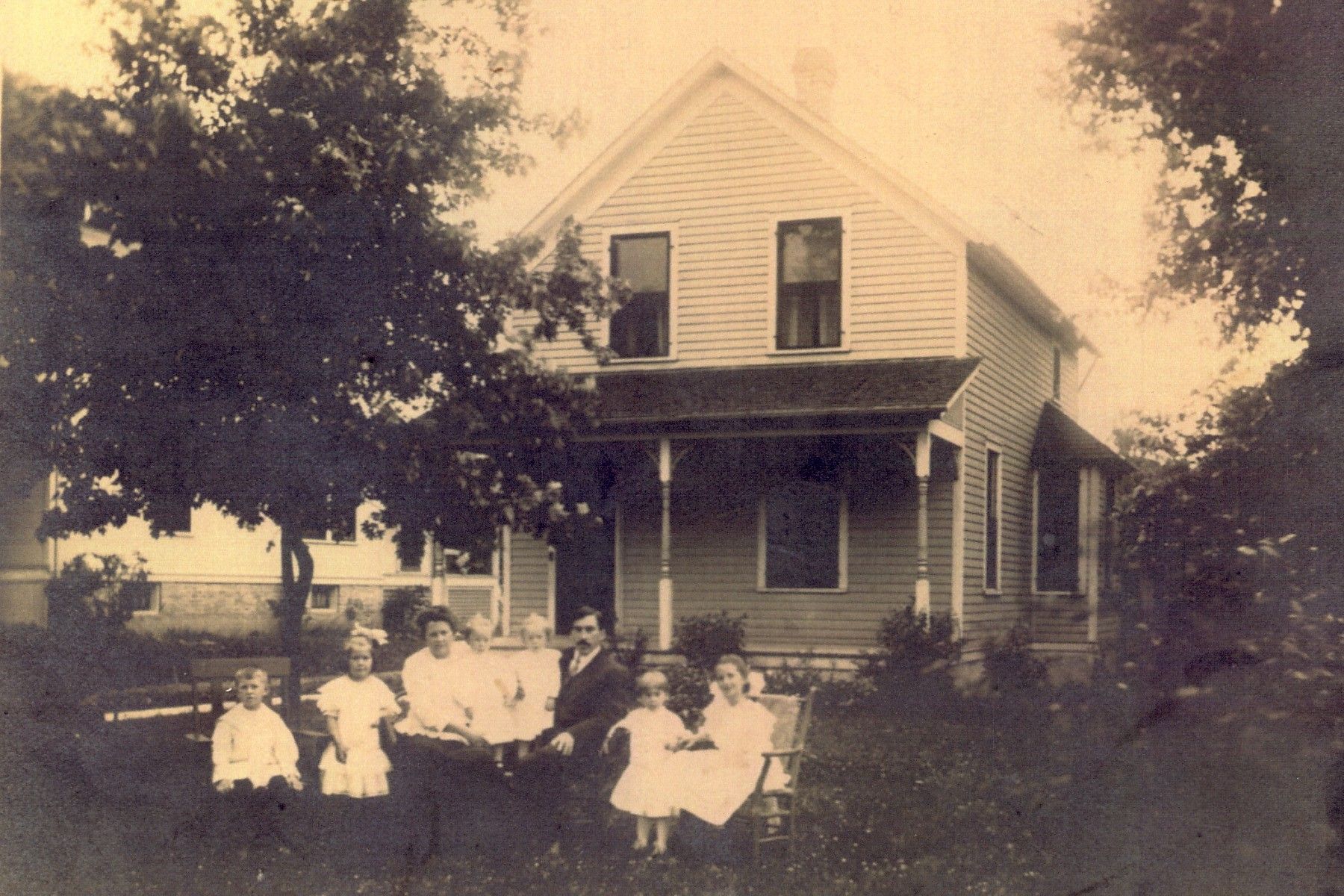
The story of the Spellman-Johnson family begins in the 1800s with Patrick Joseph Spellman. He was born in 1845 in Ontario, the first stopping place on this side of the Atlantic after his parents emigrated from Ireland. By 1850, they were living on a farm in Lake County.
Patrick married Catherine McHugh, and worked in the building trade, as a plasterer. Shortly after the birth of their son John, the Spellmans moved to Lake Forest.

Though not born in the United States, Patrick felt called to serve in the Civil War, where he was a member of the 12th Illinois Cavalry, Company A. He was wounded in the shoulder fighting in the Tennessee mountains.
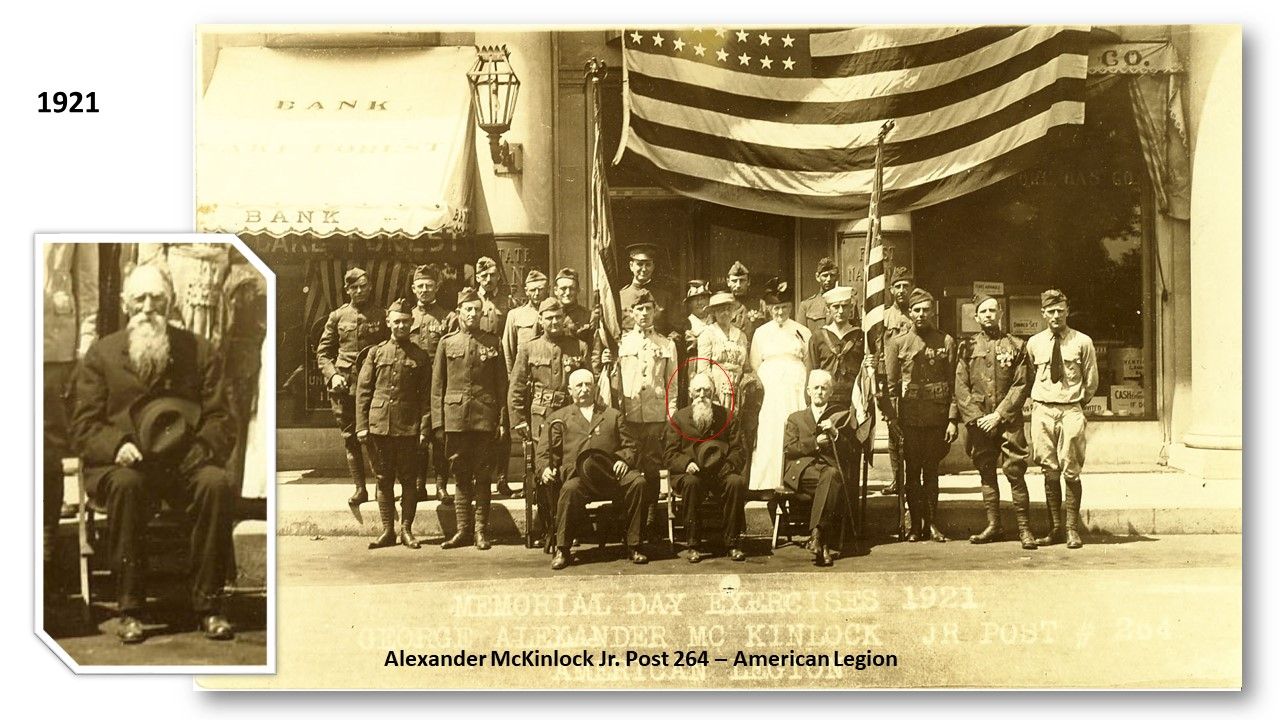
As a veteran, he was active in the Grand Army of the Republic, serving as quartermaster for the Lake Forest chapter. After World War I, when the local American Legion post was formed, he was invited to become an honorary member – he was one of only three local Civil War veterans still living when this picture was taken on Memorial Day in 1921, in front of bank building in Market Square (later Marshall Field & Co). You can see him pictured at center, with a long white beard.
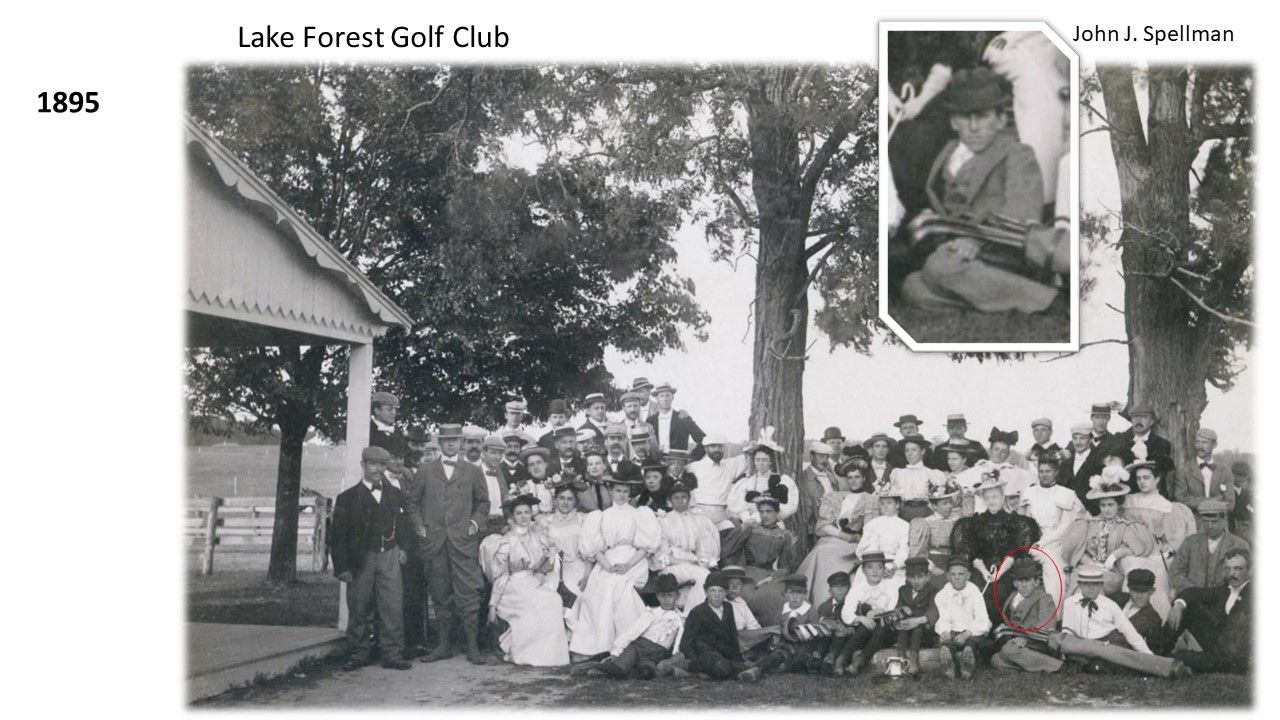
Patrick’s son John Spellman was involved with golf in Lake Forest from the very beginning. This is a picture of the first club in the area, the Lake Forest Golf Club, located near where Lake Forest Country Day School is today. The club was the forerunner of the Onwentsia Club. John Spellman is sitting on the grass with several other young boys who worked as caddies for the club, with a bag of clubs on his lap.
He golfed throughout his life, and was one of the founders of the Deerpath Golf Course when it was built in the 1920s and 1930s.
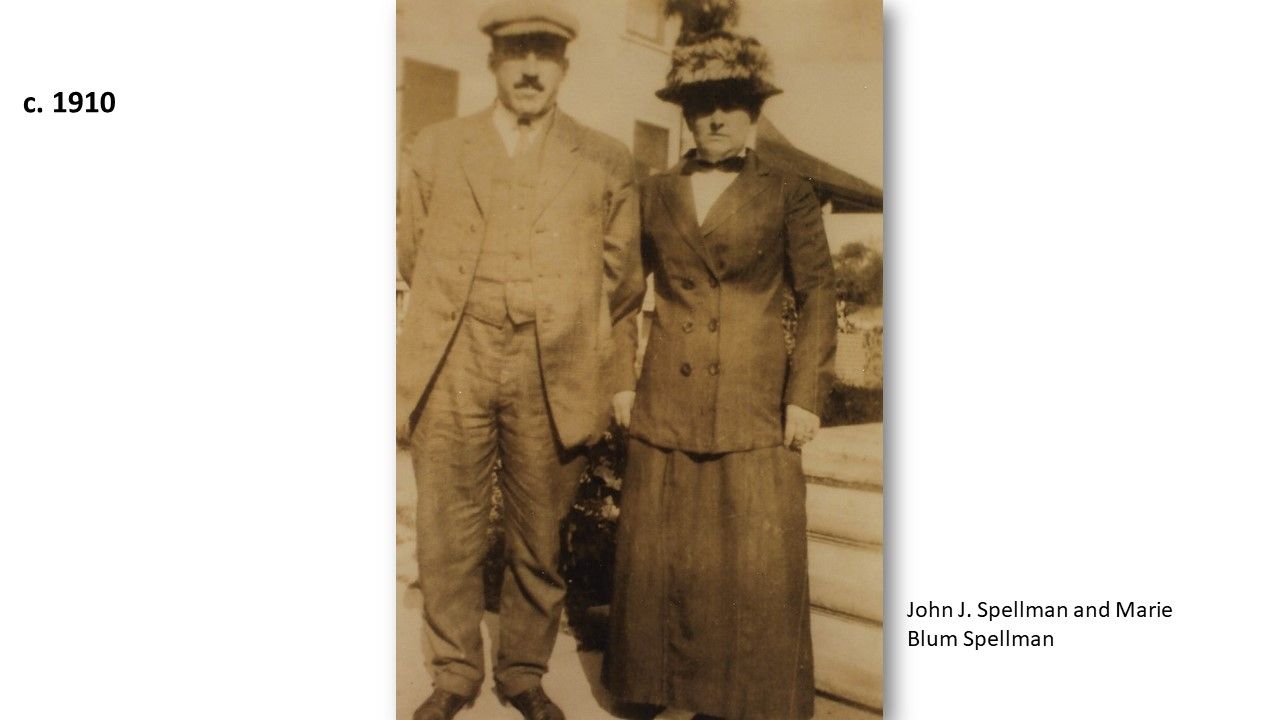
As a young man, John J. Spellman worked for the dry goods firm John V. Farwell Company in Chicago. It was there he met Marie Blum, whose family were German immigrants. They eloped in St. Joseph, Michigan, in 1899 because they had grown up with different religions – John Catholic, and Marie Lutheran.
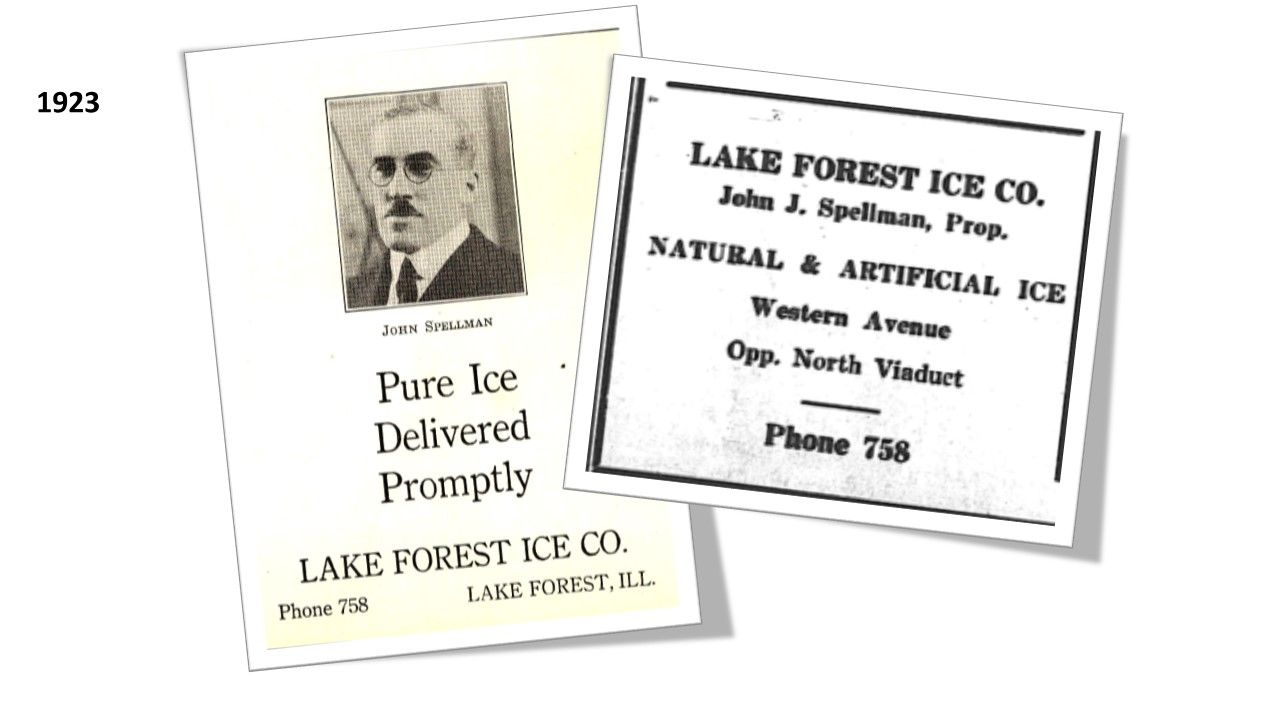
After a few years of marriage, John and Marie returned to Lake Forest. John Spellman was very enterprising; he established a storage business, and later a motor express firm and garage. He also took on ice delivery, with the Lake Forest Ice Company; the ice house was located just south of Woodland between Western and McKinley avenues. He would often travel up to Powers Lake, Wisconsin, to cut the ice.
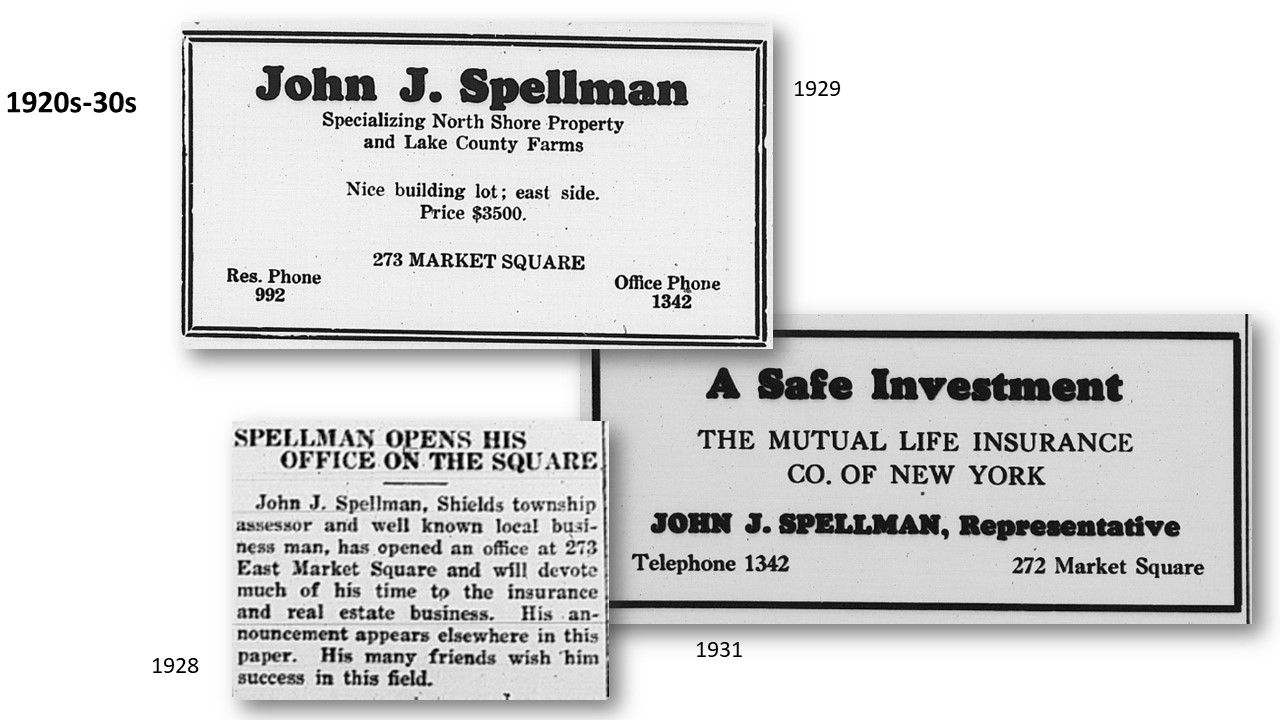
Later, in the 1920s and 1930s, John J. Spellman went into real estate and insurance, establishing an office on the second level of Market Square.
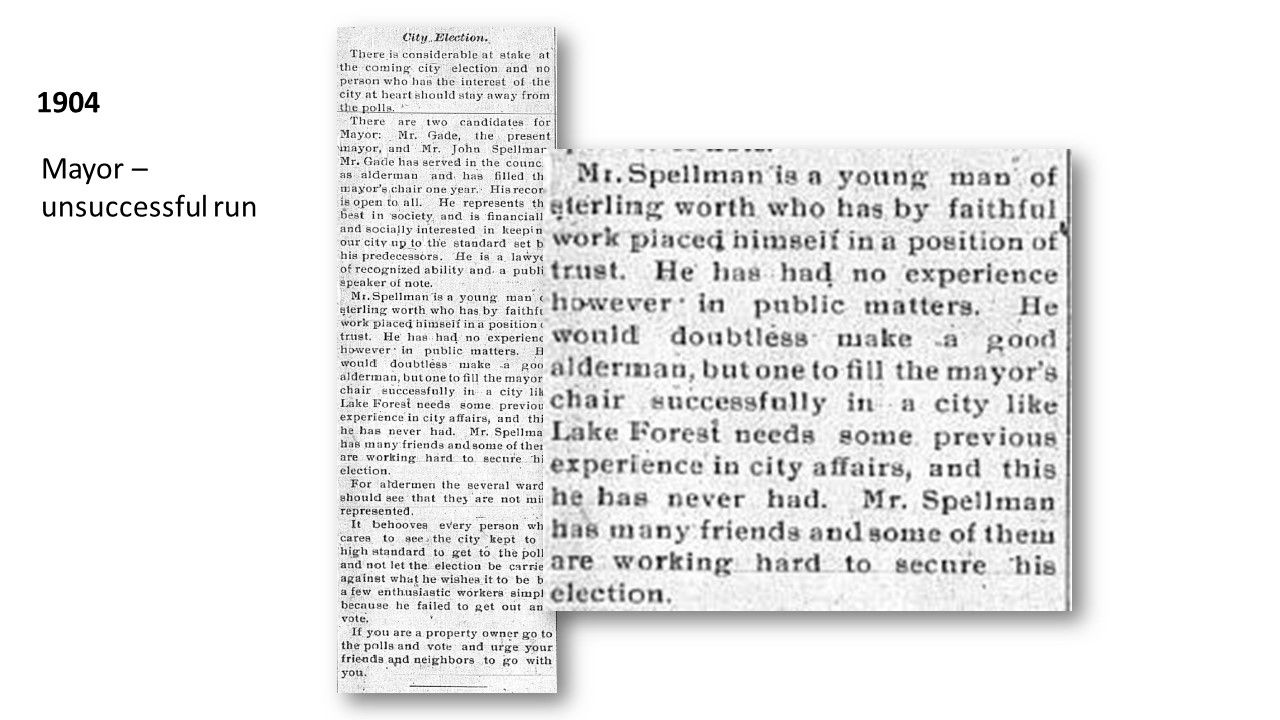
In addition to his business interests, John J. Spellman also had political ambitions. He was an intensely civic man who felt called to serve his community. This was demonstrated when, at the tender young age of 23 in 1904, he put his name in the ring for Lake Forest mayor. He did not win – Frederick Gade, who had considerably more experience, was elected – but the newspaper editorial was sufficiently impressed to call him “a young man of sterling worth who has by faithful work placed himself in a position of trust.” The editorial suggests that he would “doubtless make a good alderman,” advice he took to heart, for he ran for alderman in the next election in 1906, and served through 1909.
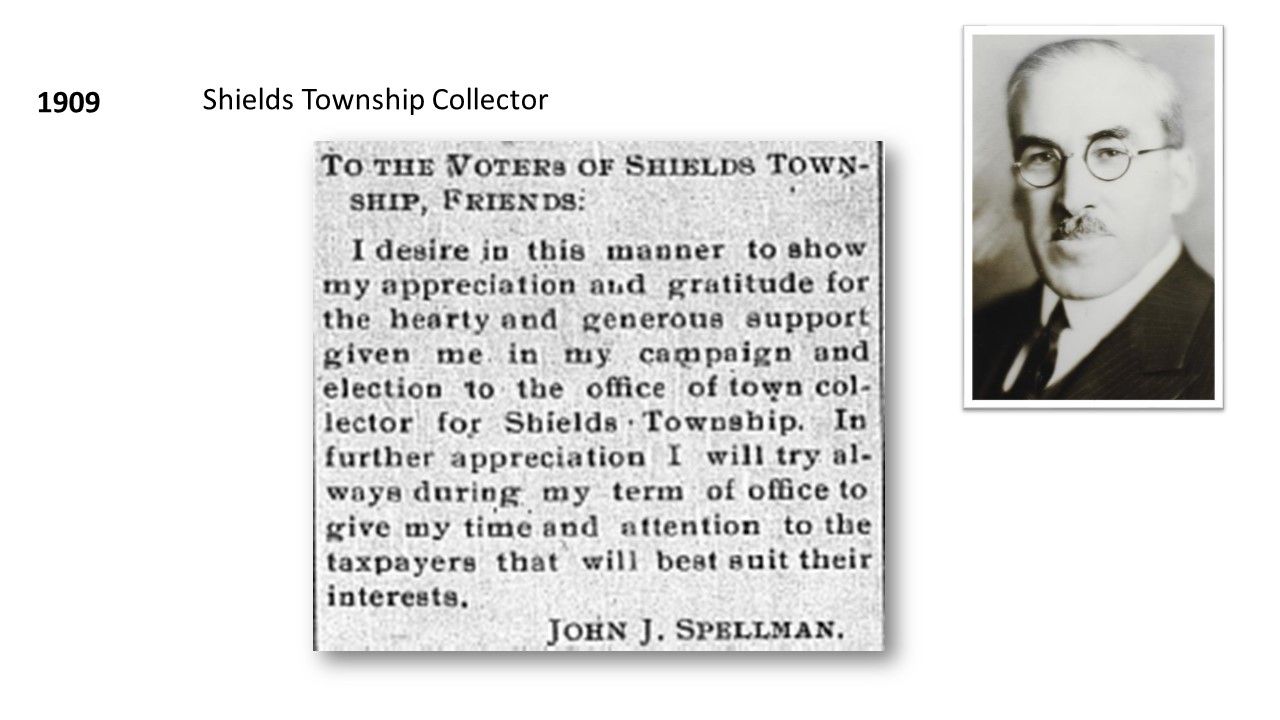
This early mayoral run was one of his few political setbacks. From 1906 to his death in 1948, he served Lake Forest, Shields Township, and Lake County in several positions and countless ways, garnering a reputation as the most civic-minded man in Lake Forest. I’ll go through a few of his roles.
In 1909, at age 29, he was elected Shields township collector, opening an office in the Matthews building next to Krafft’s drug store on Western Avenue. He served as collector for three years.
In 1917, he was appointed to the Lake Forest Board of Education, serving on the school board for 27 years. He was head of the building committee in the 1930s when the district was able to add onto or renovate all three school buildings – Everett, Halsey, and Gorton – even in the midst of the Depression. As a board member, every year he and his wife Marie would host luncheons for school teachers at their home.
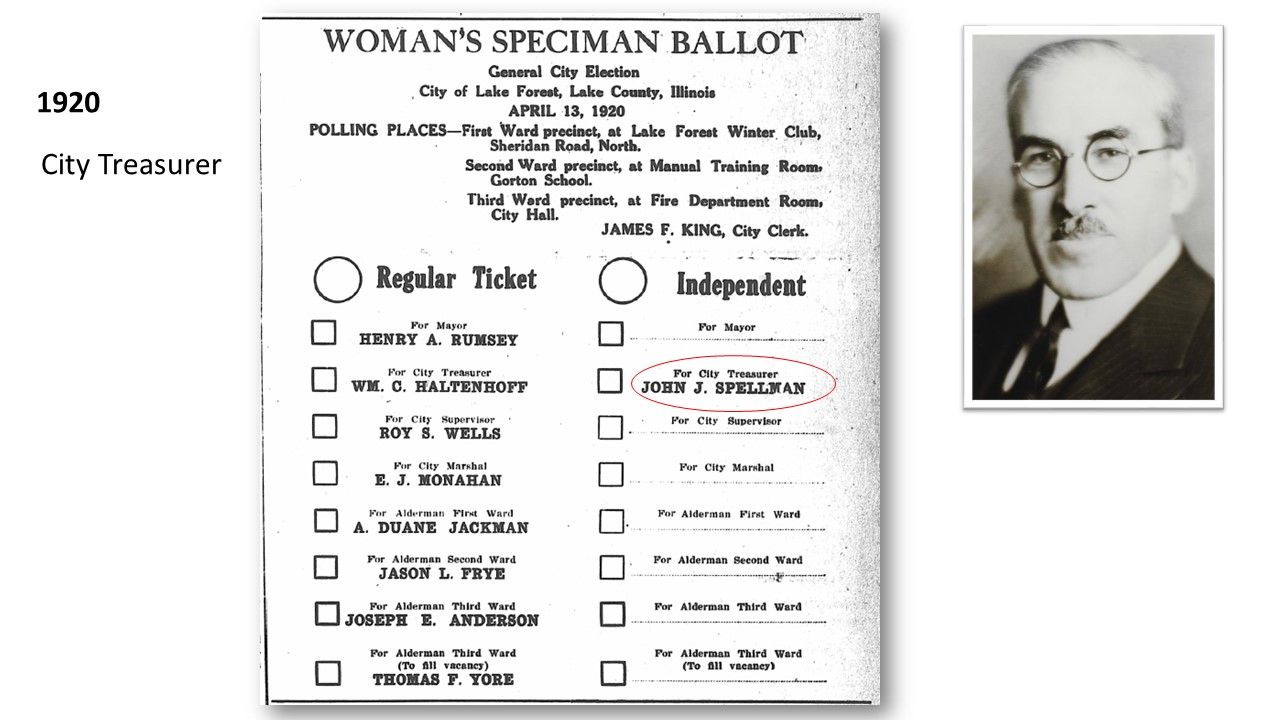
In 1920, he was elected Lake Forest city treasurer, the only independent as you can see running against the “Regular Ticket.” If you look closely at this you can see it is labeled the “Woman’s Speciman Ballot,” with this the first local election coming after the 19th Amendment was ratified (though of course Illinois women had voted in local elections since 1913).
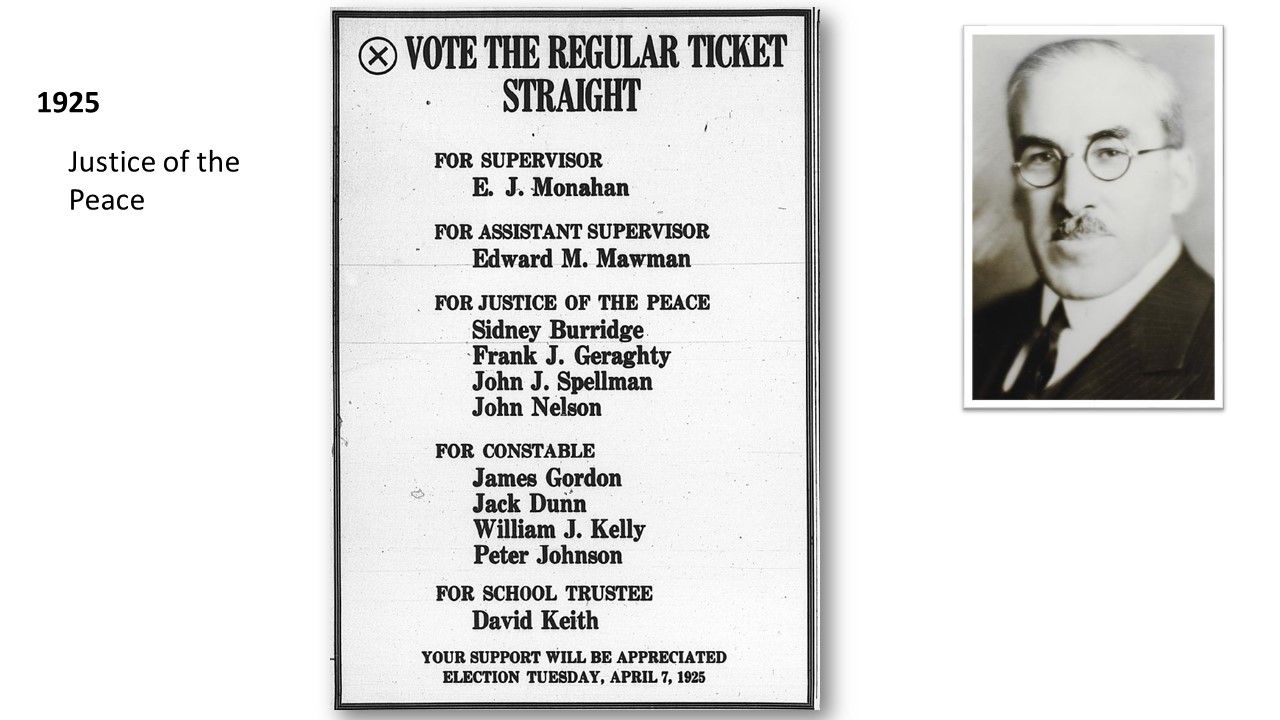
He served as treasurer for 2 years, and then in 1925 was elected Justice of the Peace.
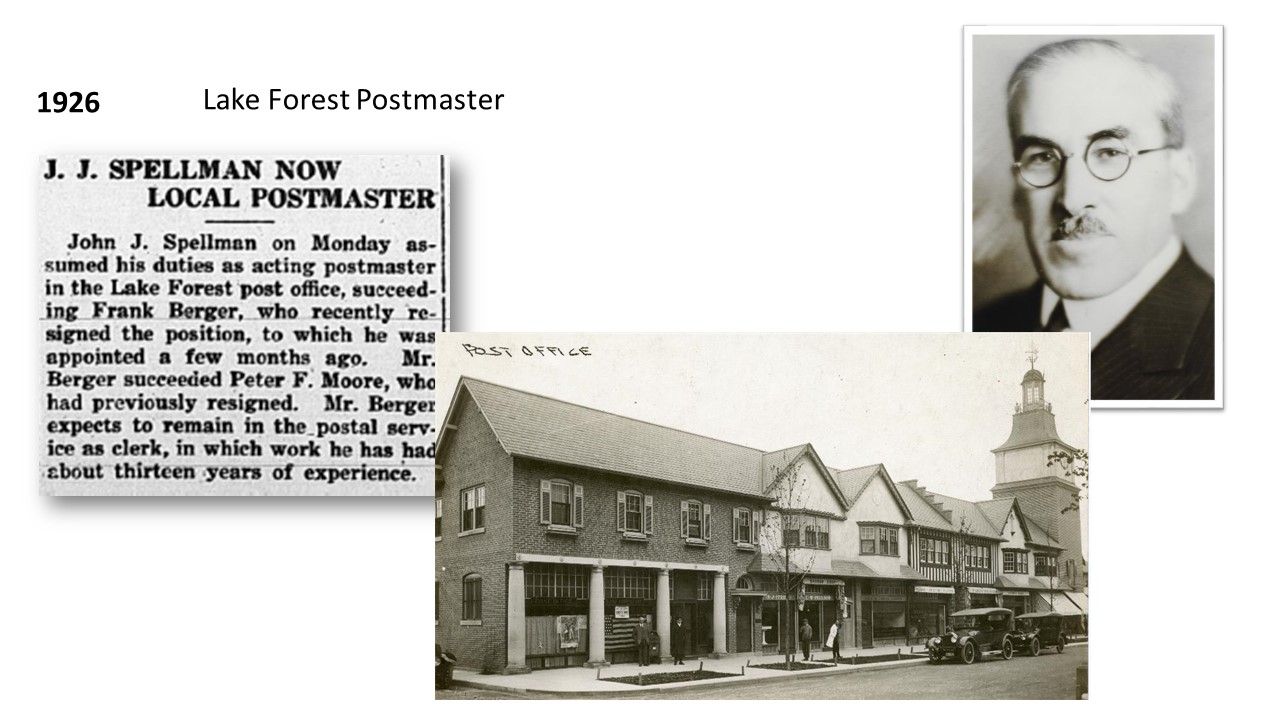
When in 1926 the new Lake Forest postmaster suddenly resigned his position after a few months on the job, it speaks to John J. Spellman’s reputation and trustworthiness – as well as to his sense of civic duty – that he was selected and willing to serve as acting postmaster for a few months until a permanent replacement could be found.
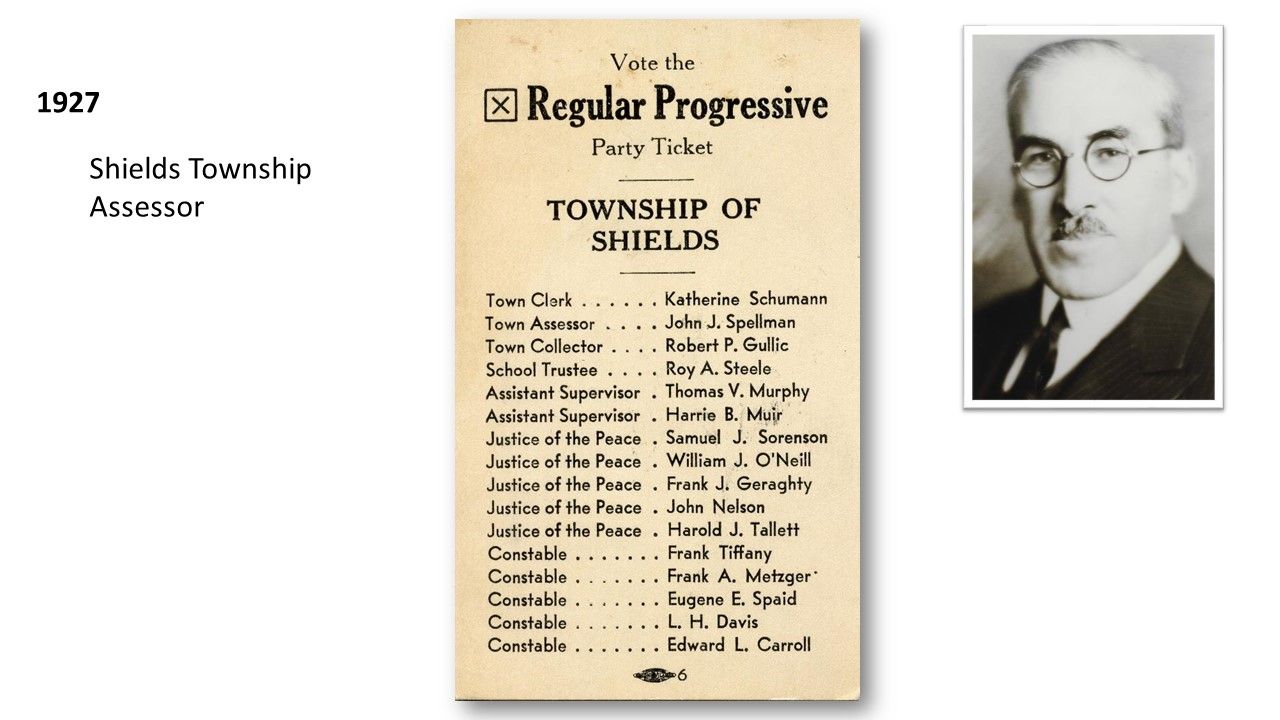
In 1927, John Spellman was elected Shields Township Assessor, a position he held for nearly 20 years into the 1940s.
Additionally, for many years, he had been involved with the central committee for the Lake County Republic Party, and in the 1940s he served as chairman.
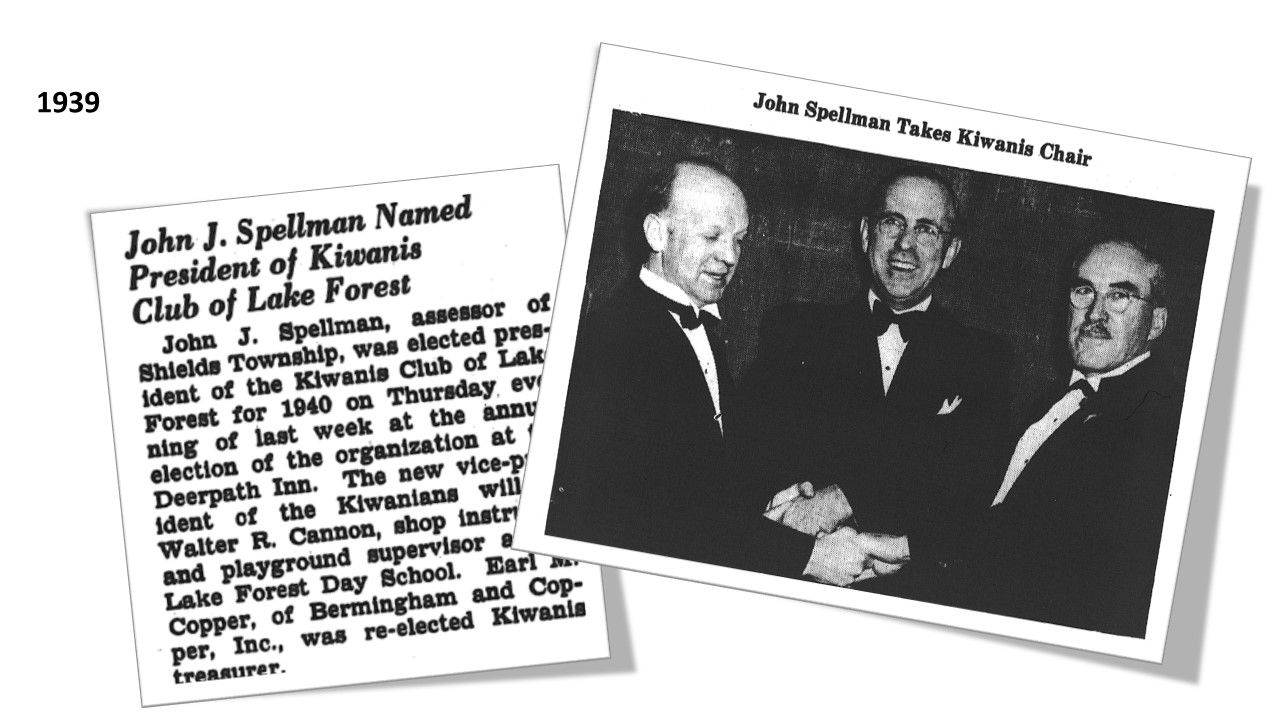
In case his business affairs and civic engagement weren’t enough to keep him busy, John Spellman was also active in a number of local organizations. He was a founding member of the Lake Forest Kiwanis Club and served as president in 1940.
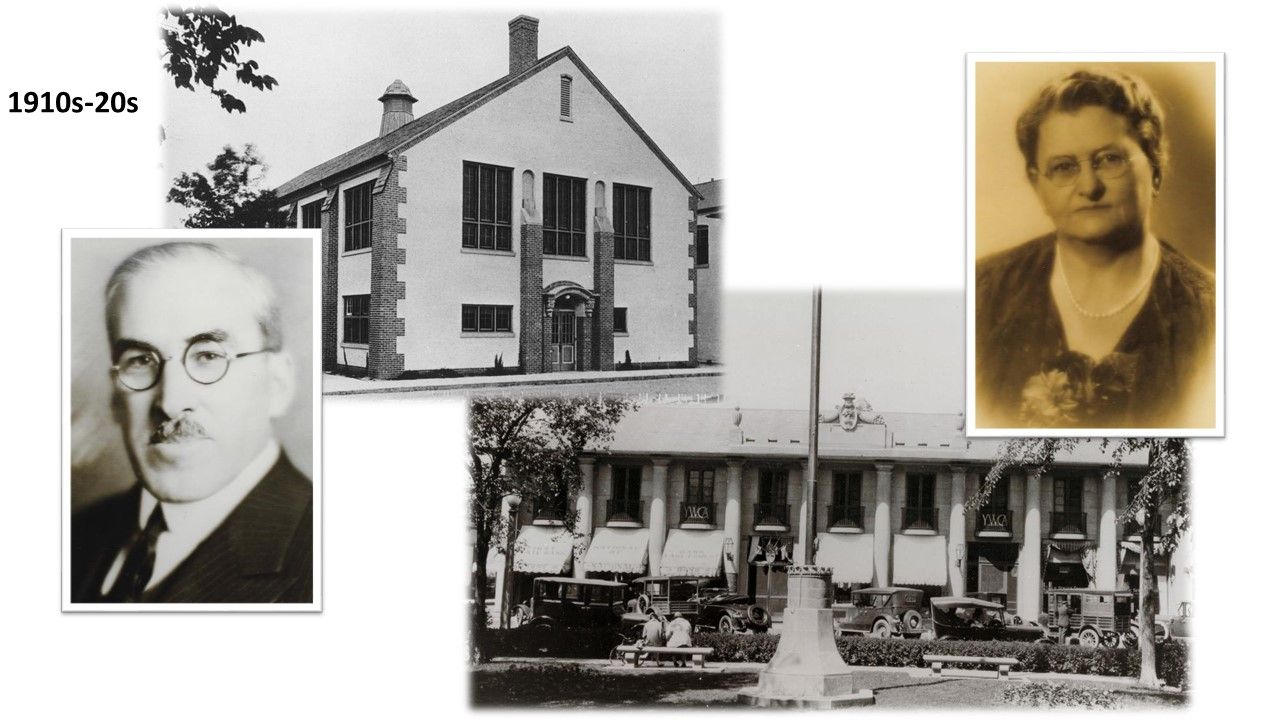
He and Marie were pillars of the Young Men’s Club and Young Women’s Christian Association, hosting events, serving on the board, volunteering as master of ceremonies for dances. The two sponsored an annual sleigh ride for the Lake Bluff Orphanage, serving them hot chocolate and cookies at the YWCA afterward.
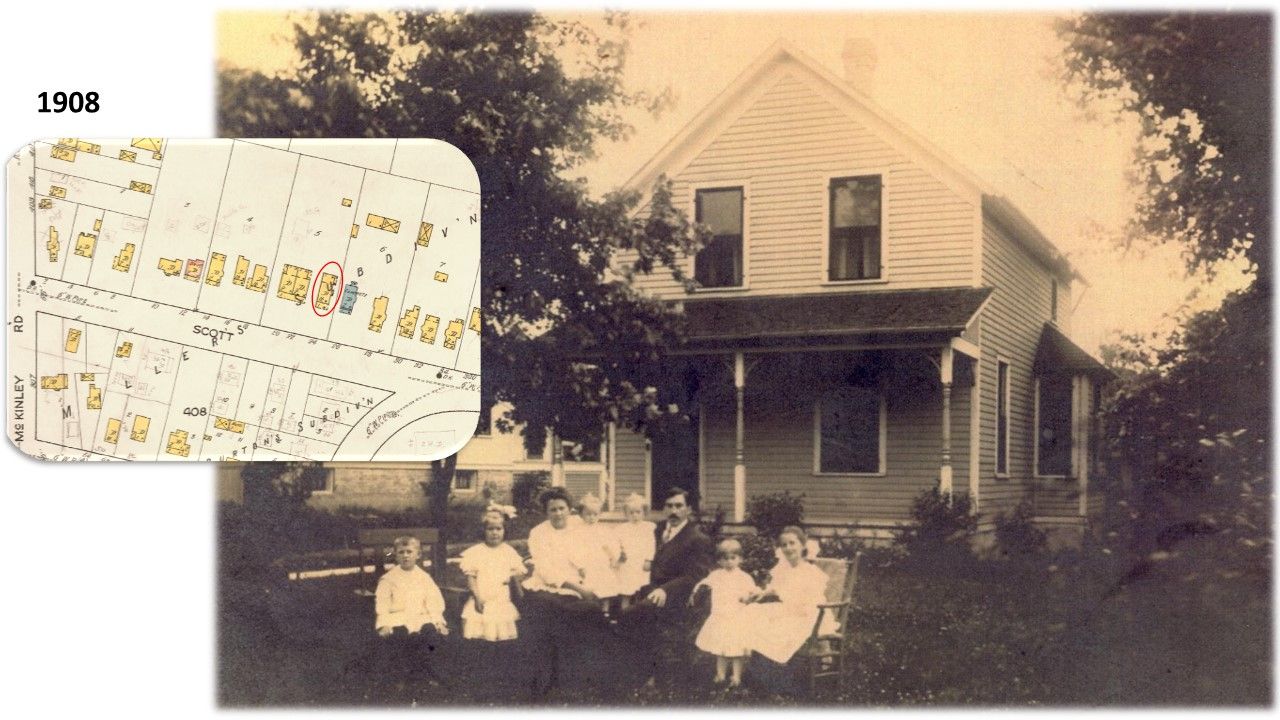
Given all this activity, it’s a wonder John Spellman had time for anything else. In fact, you can’t be surprised that he had a reputation in his family – and in town – for excessively fast driving. How else was he going to fit everything into his schedule? But John Spellman was also quite a family man. He and Marie had seven children – you can see six of them pictured here, all but the youngest, Margaret, in front of their home at 348 Scott Street. This house was a social whirl of town events, planning meetings, bridge parties, and family picnics and other gatherings. The house stood on Scott Street for many years and only recently was torn down and replaced with a new construction.
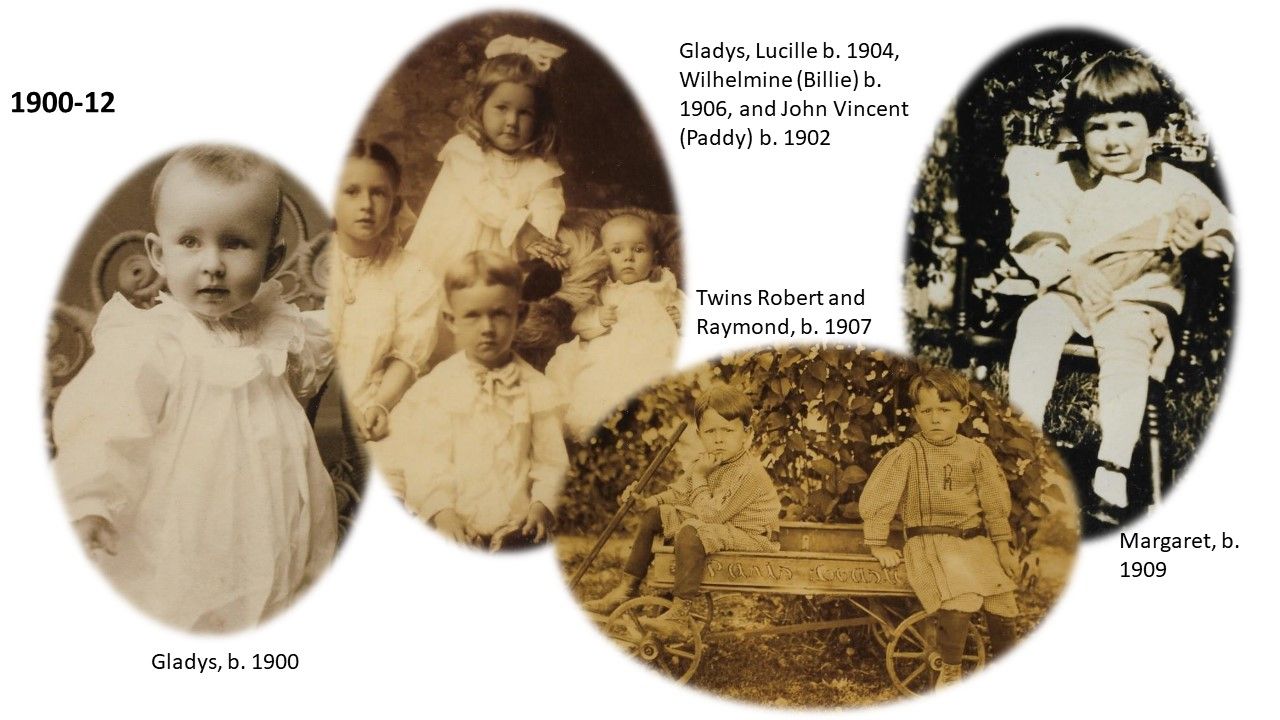
Here you can see the seven Spellman children – Gladys, the oldest, at left as a baby in 1900; then came John Vincent, or Paddy as he came to be called, Lucille, or Lu on top in the bow, and Wilhelmine, or Billie, the baby at center. Then were the twins Robert and Raymond, and finally Margaret, or Peggy, born in 1909. The Spellmans all attended Lake Forest schools, at Gorton and Halsey, and grew up just as involved as their parents, whether in Boy Scouts, baseball, or theatricals at the YWCA.
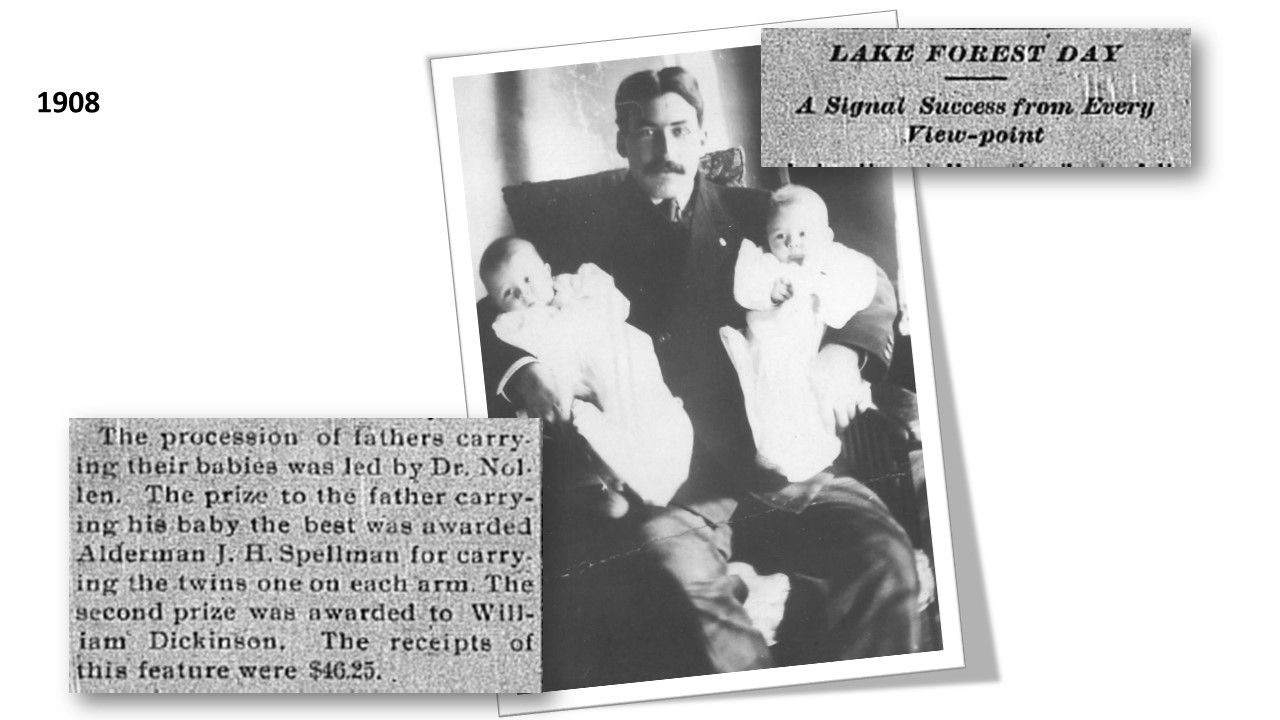
Robert and Raymond Spellman, or Bob and Ray, the twins, were born in 1907, and were still babies when the very first Lake Forest Day was held in July, 1908. They helped their father, then an alderman, carry off an award for “carrying his baby the best,” given that, with twins, he had to have one in each arm, which the other fathers found duly impressive.
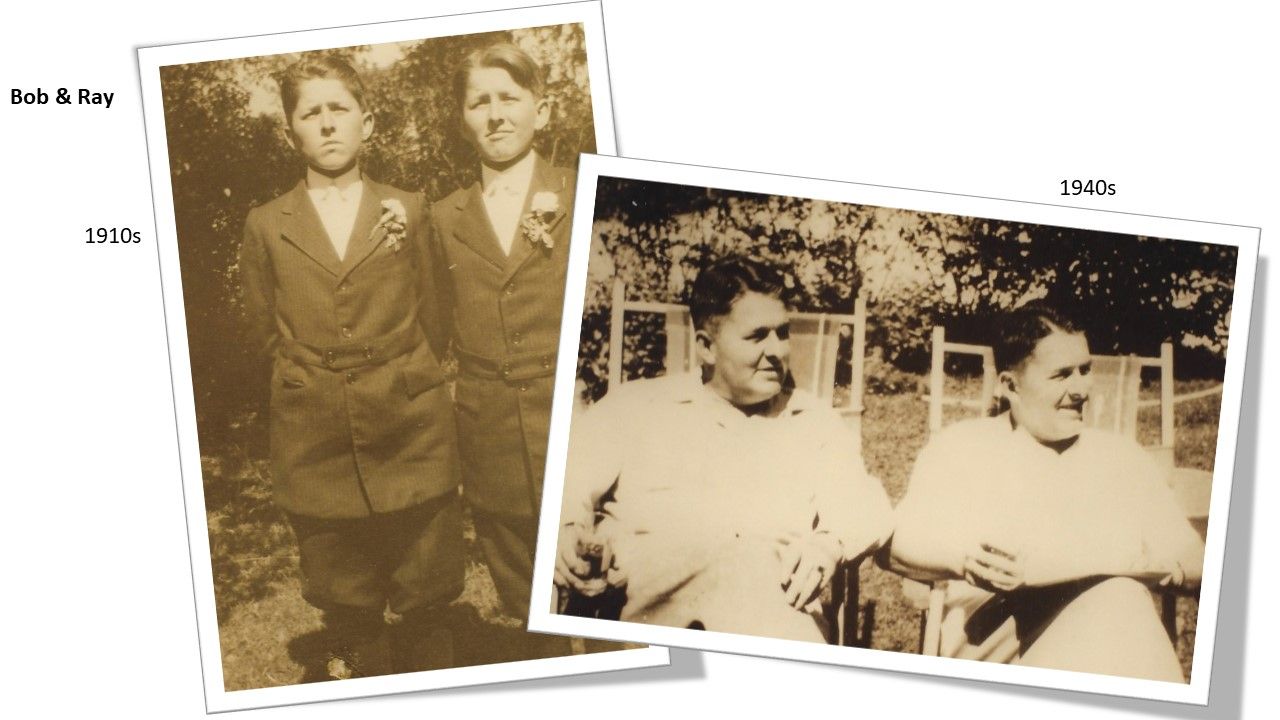
Bob and Ray were identical, and looked so much alike even as adults that favorite prank of switching places and confusing people continued to work even after 40 years.

Athletic talent ran through the family – John golfed, of course, but Billie was also quite good, taking second in a putting contest when the back nine opened at Deerpath in 1931. The twins played baseball, and Billie played basketball on the YWCA team. The standout was probably John Vincent, or Paddy. His athletic career in high school was interrupted by World War I, when he enlisted in the Navy at Great Lakes in 1917 (although he was underage). On his return, he was a standout on the football field at Deerfield-Shields High School, where all the Spellmans attended, helping the team to a Suburban League title in 1921, when he was named an all-star.

Paddy’s youngest sister Margaret was a standout in school theatricals. She launched her career as a public stenographer in the late 1920s, sharing an office on the second level of Market Square with her father’s real estate and insurance business. She also worked for several years as a secretary at the Lake Forest Day School.
In 1940, she married Mark Beaubien, a lawyer from Waukegan whose family history dated back to the earliest days of Chicago. Mark’s great-great grandfather of the same name was the proprietor of the Sauganash hotel where the village of Chicago was organized in 1833.
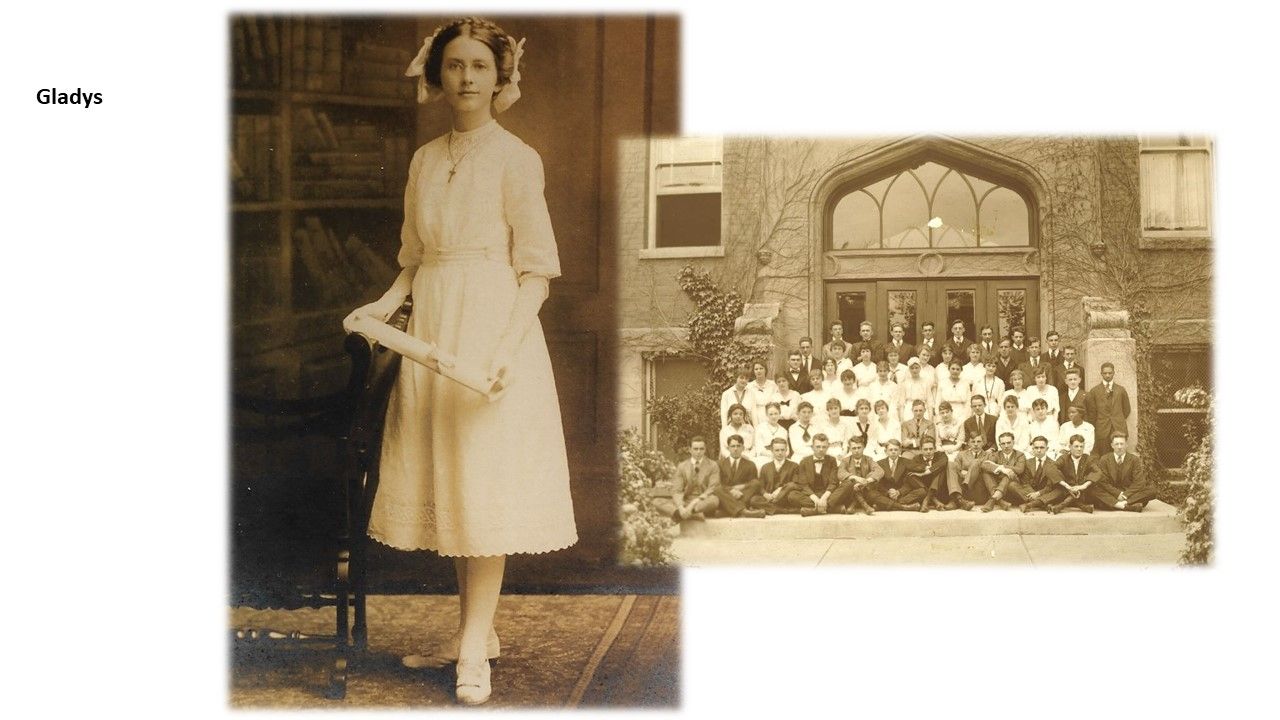
Of the seven Spellman children, the line that we will follow is that of Gladys Spellman, the eldest. She was a very good student, skipping a grade in high school, and later going on to attend a business school course.
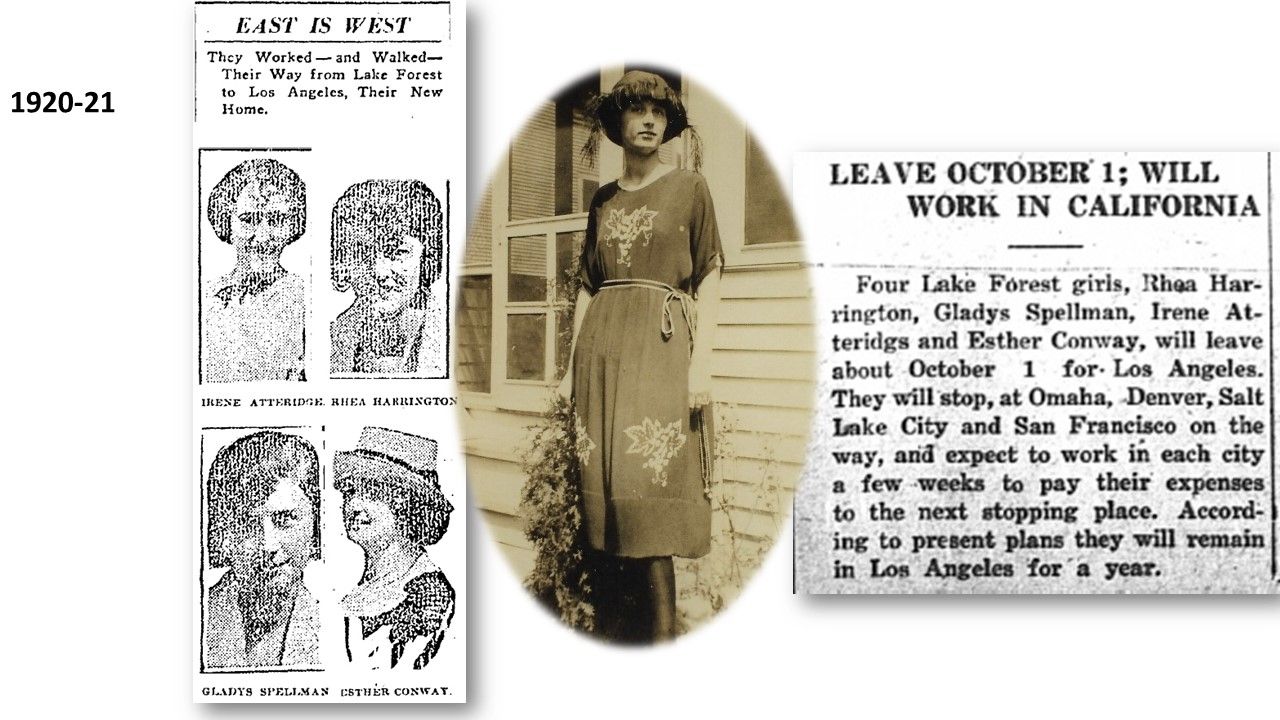
Gladys was 20 years old and working as a stenographer in John Griffith’s real estate office when, in 1920, she and her three best friends Irene Atteridge, Rhea Harrington, and Esther Conway decided to take an extended trip out to California, leaving in October. They stopped for several weeks in Omaha, Denver, and Salt Lake City, where they found work to earn money for the next leg of the trip. Some of these jobs were more lucrative than others. On the leg from Las Vegas to LA, they were obliged to ride in a baggage car for a distance of 360 miles, using trunks as both chairs and tables. The girls then spent the winter working in Los Angeles, returning to Lake Forest in April after a grand adventure.
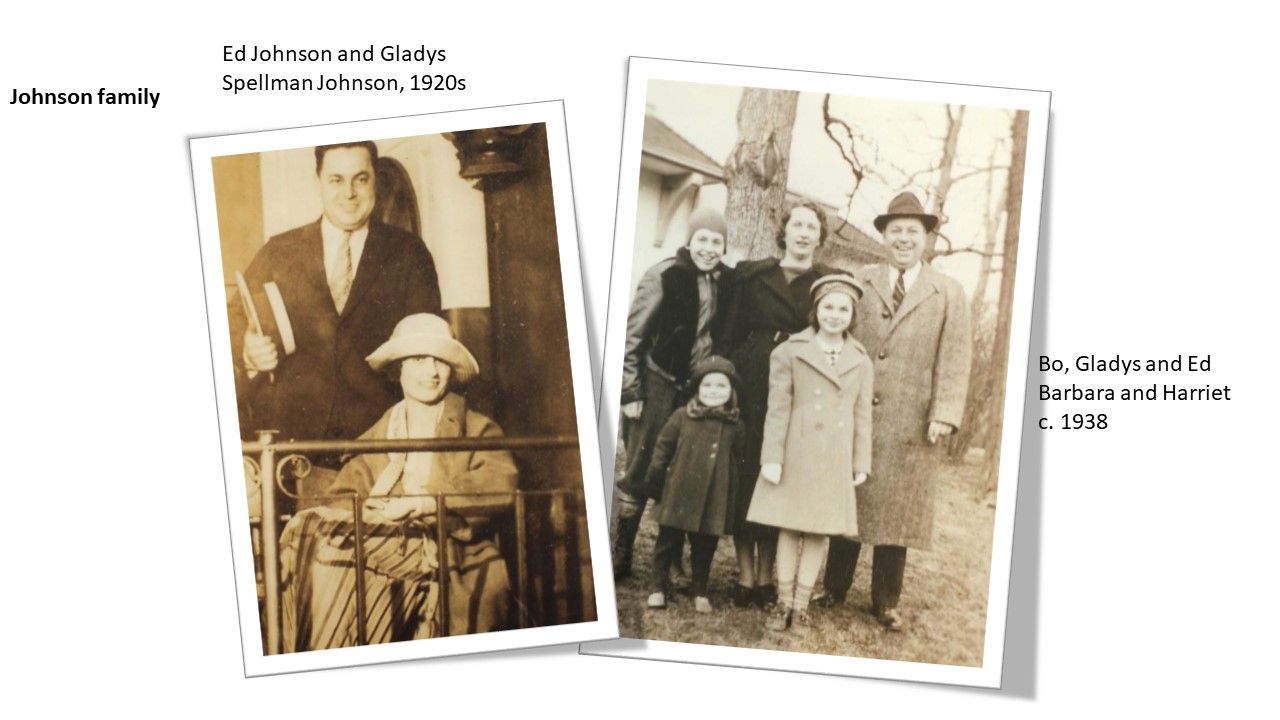
Gladys met Charles Edwyn Johnson, or Ed, when her sister Lu set her up on a blind date. Ed was a World War I vet and had attended Lake Forest College. His father, George L. Johnson, was the chairman of the General Outdoor Advertising company, and Ed went into advertising as well. Ed and Gladys were married in 1925 at St. Mary’s, and after some years in Oak Park and River Forest, moved back to the area in 1933, when they bought a house at 222 E. Prospect, in Lake Bluff. The Johnsons had four children – Edwyn Locey, or Bo, Harriet Marie, Barbara Leigh, and Nancy Ann – the three oldest are pictured here.
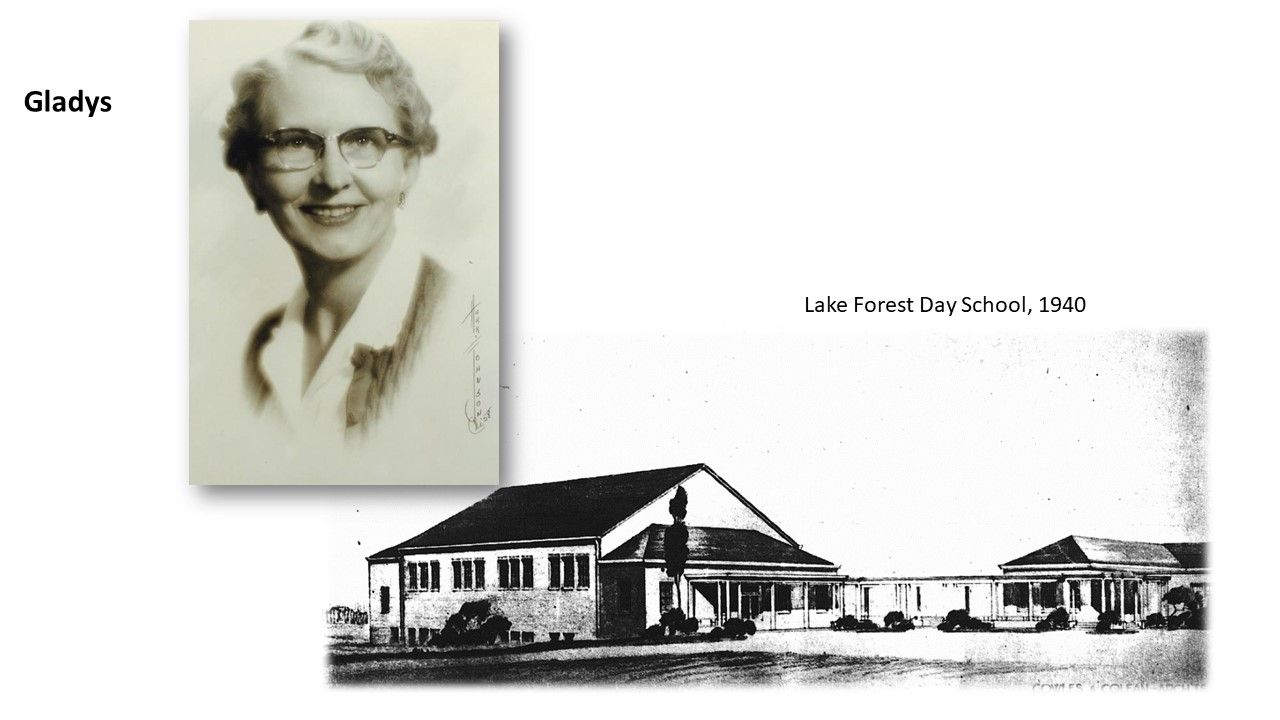
The Johnsons faced the unexpected in 1943, when Ed died at age 45, leaving Gladys and the four children, between ages 16 and 2. Gladys worked as a secretary at the Lake Forest Day School, and the family moved several times, first to Scranton Avenue, then to the family home at Scott Street to help care for John Spellman, then a widower, to a garage apartment near the Masonic Lodge, and then to apartments above the Surprise Shop (now Talbot’s) and Forest Bootery in Market Square.
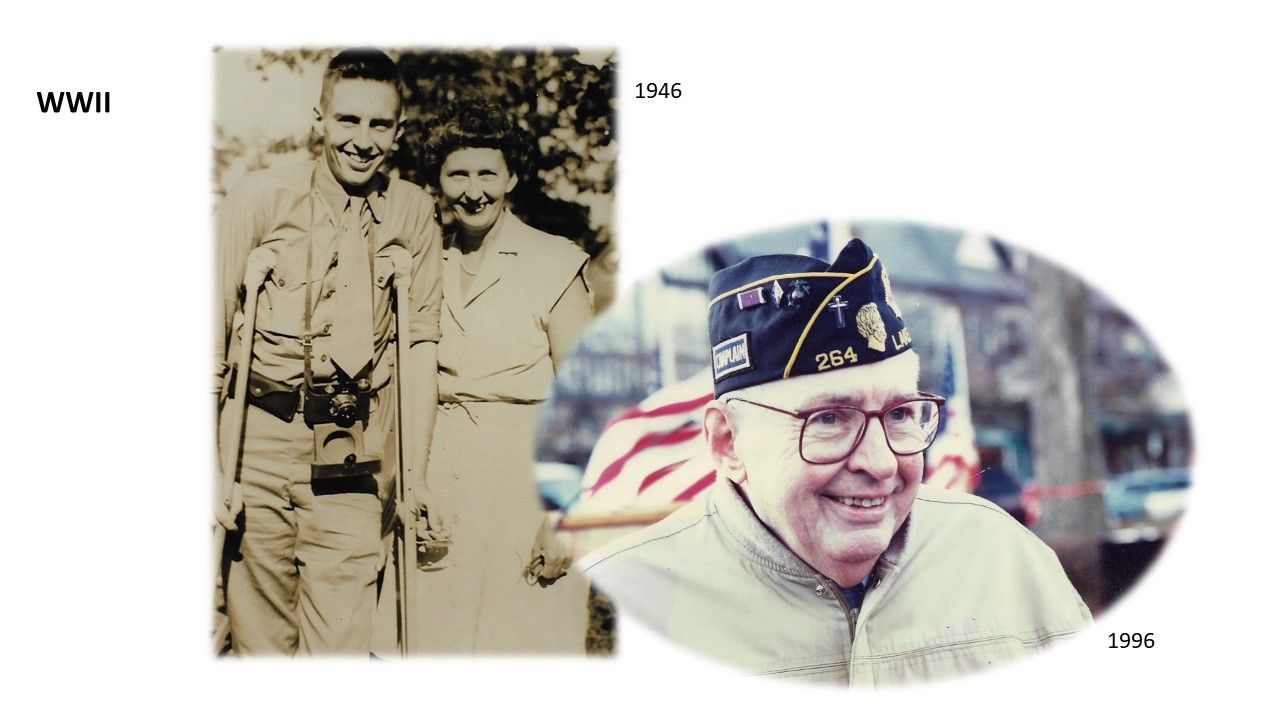
Bo Johnson graduated from Lake Forest High School in 1944 – like many of his cohorts, he went from football practice to boot camp, serving in the Marines in World War II. Bo was injured at Okinawa in June, 1945, wounded in the leg and shoulder. After being hit the first time, a corpsman was working on the shoulder wound when the order came to move out. While putting on his jacket and pack, Bo was hit again, much more severely in the leg. By the time he was able to “regroup,” he realized the rest of the outfit was gone. His letters home later tell of his determined efforts – alone in enemy territory for 36 hours – to find the U.S. troops, safety, and care for his wounds. Later he spent time in recovery on the West Coast, in the Memphis military hospital, and then finally at Great Lakes, where he could see his family. You can see him pictured here in 1946 with his mother after making it home, and then at Memorial Day in 1996 with the American Legion, whom he served as Chaplain.
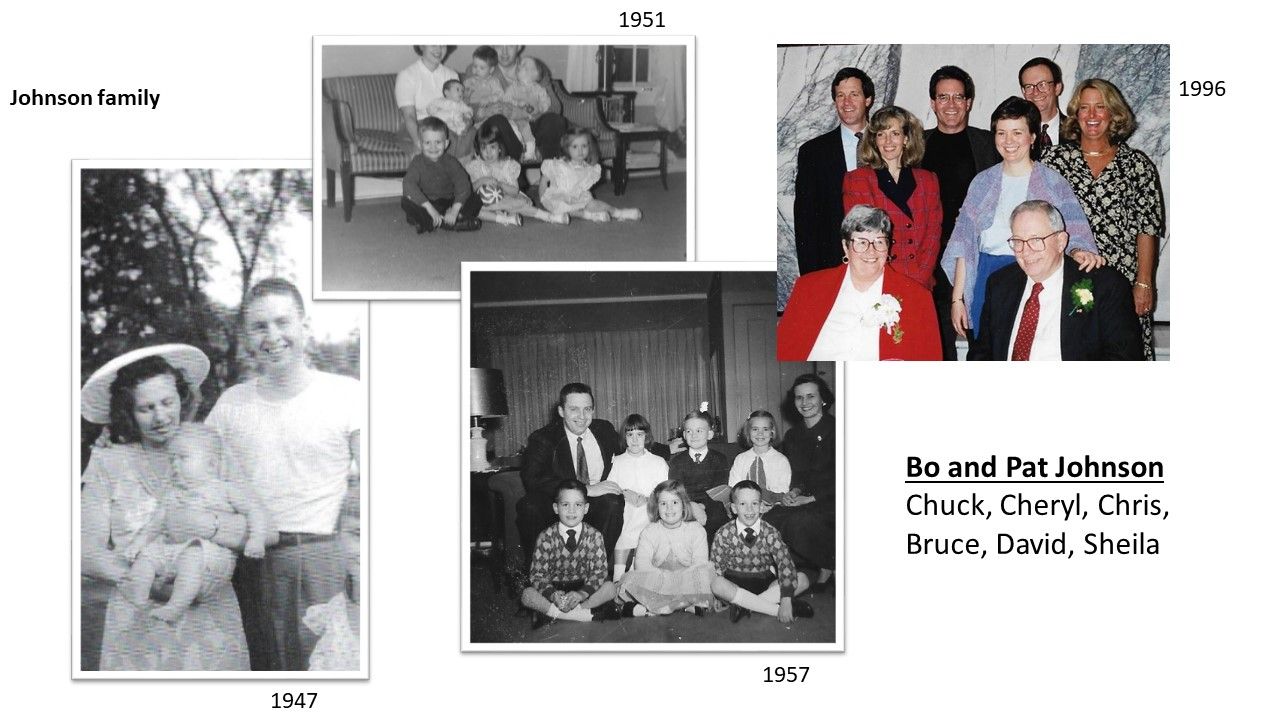
Bo Johnson attended grade school in Lake Bluff, and he knew that he would marry “new girl” Pat Olson when he first saw her in 8th grade. They started dating between sophomore and junior year – while on a double date with others, they realized they’d rather be on one with each other, and were prom king and queen their junior year. They married in 1946, right after the war.
Pat’s father, Gus Olson, was a Swedish immigrant, and built dozens of homes in Lake Forest and Lake Bluff. Bo worked for him for a time as a carpenter, and then became a kitchen designer and worked for several kitchen cabinet companies. He was that sports parent, very involved with his kids’ baseball games and prone to take it out on the umpires, until one day someone finally came up to his and said, “Okay, if you think this is easy, you become an umpire.” So he did – Bo worked for many years as a sports referee, officiating high school and college football, basketball, baseball and wrestling. Pat would coordinate the umpires for the North Shore Official Association. She also worked at Helander’s for many years.
In July, 1948, Bo and Pat Johnson moved with their first son Charles Edwin – Chuck - into a two-bedroom apartment above The Lantern – and had five more children there: Cheryl, Christine, twins Bruce and David, and Sheila. (It was, if you’re keeping score, six kids in less than five years.) Then in 1954 they moved to 595 E. Illinois, right across from the college football field – a perfect spot for growing, athletic kids. The Johnson boys even had opportunities to play football with the Chicago Cardinals and then the Chicago Bears when they practiced there.
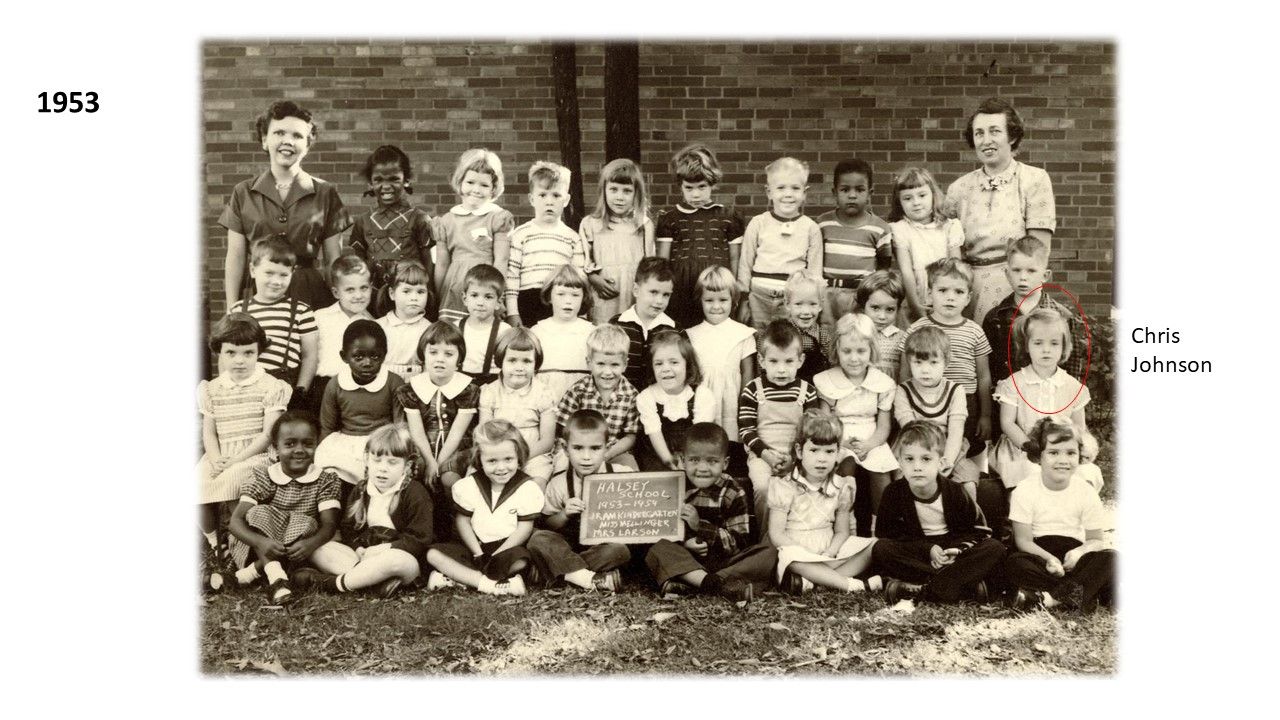
The Johnson children attended Halsey School (at least until it was torn down in 1955), Gorton, Deerpath and Lake Forest High School. Between the six of them and their many cousins, aunts and uncles, the family had someone at LFHS almost non-stop from the 1940s to the 1990s. Here you can see Chris Johnson’s junior kindergarten class at Halsey. Being in the middle of six kids very close in age, when Chris got to high school everyone knew her brother Chuck and sister Sherry, so she was “Little Johnson” – in fact, the first paper she wrote once she got to college was about how nice it was to finally be known by her name.
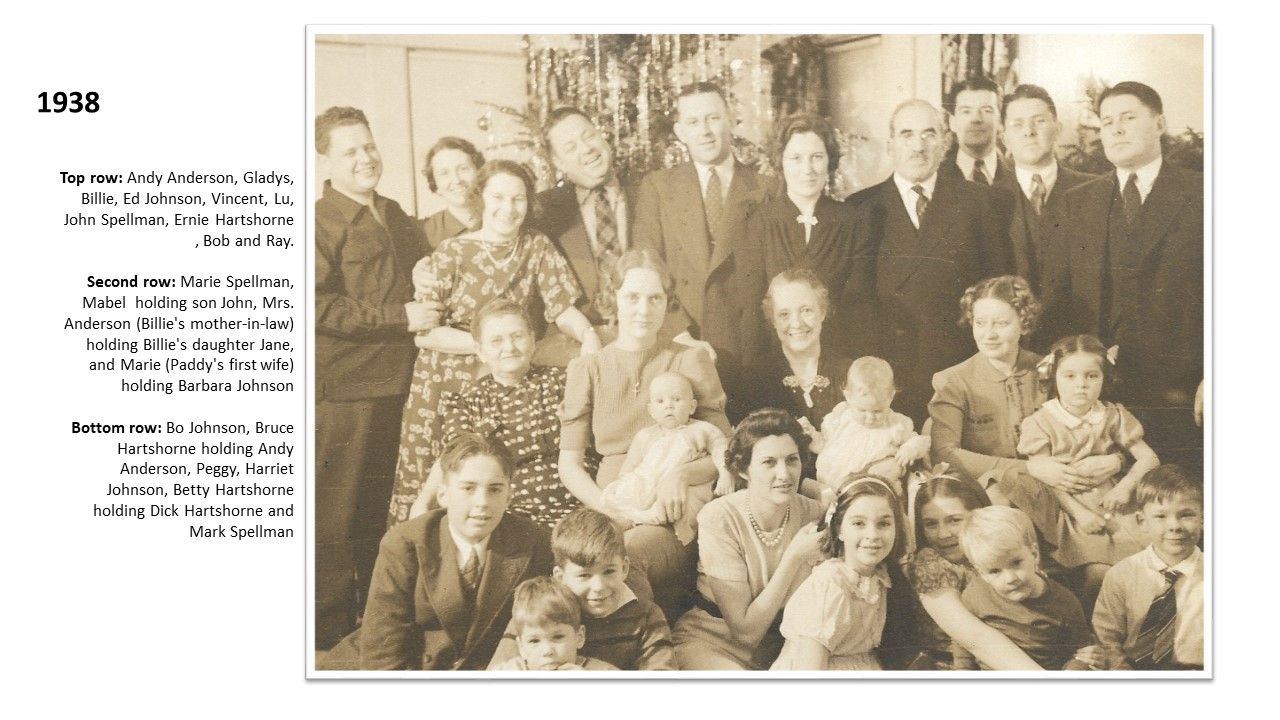
One theme that carries throughout the generations of the Spellman family was that they knew how to throw a party. Here you can see three generations gathered at Christmas in 1938 – Christmas was always a time for John and Marie’s children and grandchildren to gather at Scott Street, though many of them were far-flung by then.
Newspaper accounts tell us of other Spellman parties – a joint party hosted in 1921 by the Young Men’s Club and the YWCA sounds like quite a good time. Quote: “Maybe it isn’t fair to tell why the old-fashioned dances didn’t materialize at 10 o’clock but the social committee must be vindicated. They had it on the program and John Spellman was to supervise it. It is not known whether he visited the keg too often or whether he was bewitched by the ‘little devils’ early in the evening but the fact remains that he danced every dance in the big gymnasium. No alibis have been accepted.”
Another party that sounds like it may have been too much fun was a bobsled party hosted by Billie Spellman in 1927. Newspaper notices in the weeks following the party revealed that not one but two guests had gone too fast or been upset on the bobsled, with one confined to her house with a fractured knee caused by a spill, and another laid up at Alice Home Hospital.
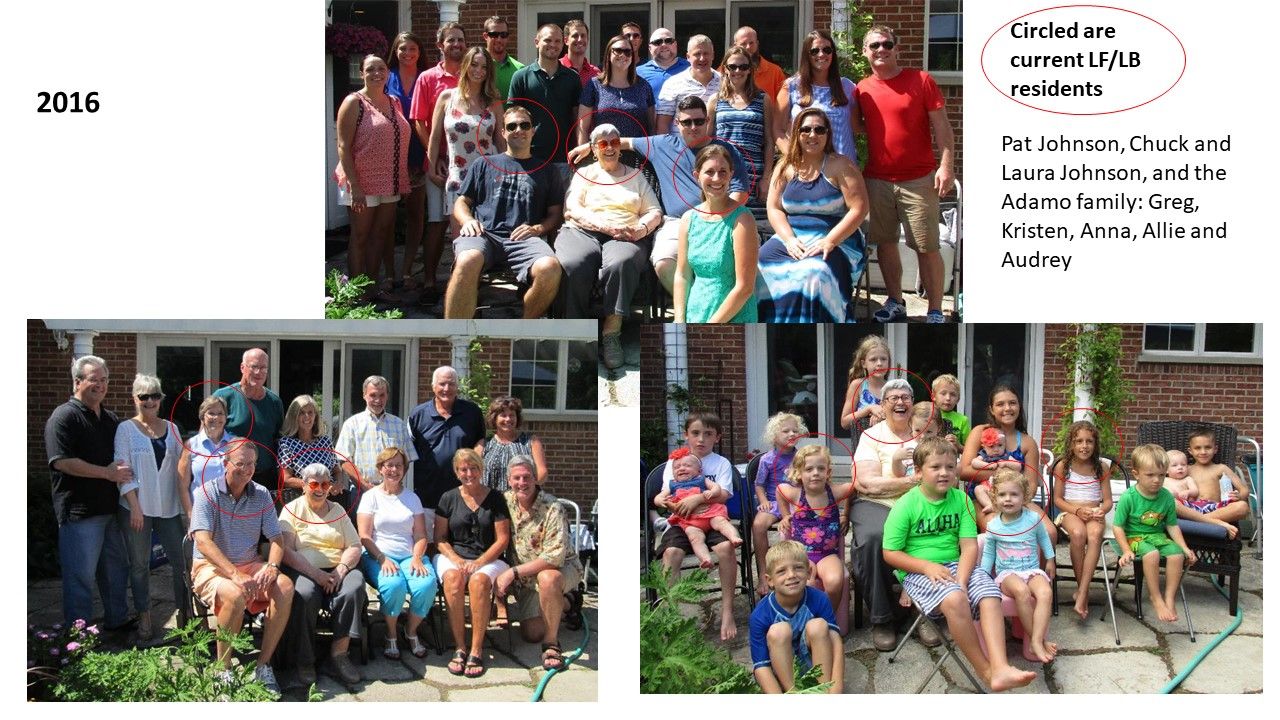
Here is the current Johnson clan, pictured in 2016 – those circled in red are current Lake Forest/Lake Bluff residents. Four generations – her children, grandchildren, and great-grandchildren, are pictured around Pat Johnson, who turned 90 that year. The youngest are the great-great-great-great grandchildren of Patrick Spellman.
Pat Johnson also brings us full circle in this presentation – she worked for several years back for none other than Lake Forest Flowers, taking phone orders before special holidays.